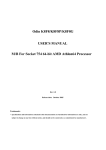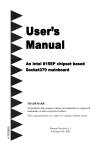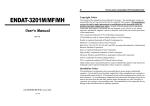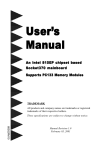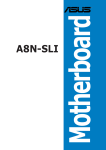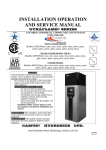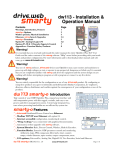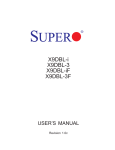Download - Foxconn
Transcript
Statement: This manual is the intellectual property of Foxconn Inc. Although the information in this manual may be changed or modified at any time, Foxconn does not obligate itself to inform the user of these changes. Trademark: All trademarks are the property of their respective owners. Version: User’s Manual V1.1 in English for NF4K8MC/NF4XK8MC series motherboard. P/N: 91-181-NF4-KX-1E Symbol description: Note: refers to important information that can help you to use motherboard better. Attention: indicates that it may damage hardware or cause data loss, and tells you how to avoid such problems. Warning: means that a potential risk of property damage or physical injury exists. More information: If you want more information about our products, please visit the following website: http://www.foxconnchannel.com NF4K8MC&NF4XK8MC-manual-English-preface.p651 2005-4-18, 15:13 Declaration of conformity HON HAI PRECISION INDUSTRY COMPANY LTD 66 , CHUNG SHAN RD., TU-CHENG INDUSTRIAL DISTRICT, TAIPEI HSIEN, TAIWAN, R.O.C. declares that the product Motherboard NF4K8MC/NF4XK8MC is in conformity with (reference to the specification under which conformity is declared in accordance with 89/336 EEC-EMC Directive) EN 55022/A1: 2000 Limits and methods of measurements of radio disturbance characteristics of information technology equipment EN 61000-3-2/A14:2000 Electromagnetic compatibility (EMC) Part 3: Limits Section 2: Limits for harmonic current emissions (equipment input current <= 16A per phase) EN 61000-3-3/A1:2001 Electromagnetic compatibility (EMC) Part 3: Limits Section 2: Limits of voltage fluctuations and flicker in low-voltage supply systems for equipment with rated current <= 16A EN 55024/A1:2001 Information technology equipment-Immunity characteristics limits and methods of measurement Signature : Printed Name : Place / Date : James Liang NF4K8MC&NF4XK8MC-manual-English-preface.p652 Position/ Title : TAIPEI/2005 Assistant President 2005-4-18, 15:13 Declaration of conformity Supplementary Information: This device complies with Part 15 of the FCC Rules. Operation is subject to the following two conditions : (1) this device may not cause harmful interference, and (2) this device must accept any interference received, including interference that may cause undesired operation. Tested to comply with FCC standards. Signature : NF4K8MC&NF4XK8MC-manual-English-preface.p653 Date : 2005 2005-4-18, 15:13 Table of Contents Chapter Product Introduction Main Features .............................................................................................. 2 Motherboard Layout .................................................................................... 4 Chapter Installation Instructions CPU .............................................................................................................. 7 Memory ....................................................................................................... 11 Power Supply ............................................................................................ 13 Rear Panel Connectors .............................................................................. 14 Other Connectors ...................................................................................... 16 Expansion Slots ......................................................................................... 20 Jumpers ..................................................................................................... 22 Chapter BIOS Description Enter BIOS Setup ....................................................................................... Main menu ................................................................................................. Standard CMOS Features .......................................................................... BIOS Feature ............................................................................................. 26 26 28 31 Advanced BIOS Features .......................................................................... 32 Advanced Chipset Features ...................................................................... 34 Integrated Peripherals ................................................................................ 36 Power Management Setup ......................................................................... 39 PnP/PCI Configurations ............................................................................... 41 PC Health Status ........................................................................................ 42 Load Fail-Safe Defaults ............................................................................. 43 Load Optimized Defaults ............................................................................ 43 Set Supervisor/User Password ................................................................. 43 Save & Exit Setup ...................................................................................... 44 Exit Without Saving .................................................................................... 44 NF4K8MC&NF4XK8MC-manual-English-preface.p654 2005-4-18, 15:13 Table of Contents Chapter Driver CD Introduction Utility CD content ........................................................................................ Start to install drivers ................................................................................. Chapter NVIDIA RAID Introduction NVIDIA RAID ............................................................................................. NF4K8MC&NF4XK8MC-manual-English-preface.p655 2005-4-18, 15:13 Warning: 1. Attach the CPU and heatsink using silica gel to ensure full contact. 2. It is suggested to select high-quality, certified fans in order to avoid damage to the motherboard and CPU due to high temperature. 3. Never turn on the machine if the CPU fan is not properly installed. 4. Ensure that the DC power supply is turned off before inserting or re moving expansion cards or other peripherals, especially when you insert or remove a memory module. Failure to switch off the DC power supply may result in serious damage to your system or memory module. Warning: We cannot guarantee that your system will operate normally while overclocked. Normal operation depends on the overclock capacity of your device. Attention: Since BIOS programs are upgraded from time to time, the BIOS description in this manual is just for reference. We do not guarantee that the content of this manual will remain consistent with the actual BIOS version at any given time in the future. Attention: The pictures of objects used in this manual are just for your reference. Please refer to the physical motherboard. NF4K8MC&NF4XK8MC-manual-English-preface.p656 2005-4-18, 15:13 This manual is suitable for motherboard of NF4K8MC/ NF4XK8MC series. Each motherboard is carefully designed for the PC user who wants diverse features. -L -K with onboard 10M/100M LAN with onboard 1Giga LAN -6 -8 with 6-channel audio with 8-channel audio -E -S with 1394 function with SATA function -R with RAID function You can find PPID label on the motherboard. It indicates the functions that the motherboard has. For example: On the blue mark of the PPID label, it means the motherboard supports 6-channel Audio (-6), 1394 port (-E), onboard 10M/100M LAN (-L), SATA function (-S). NF4K8MC&NF4XK8MC-manual-English-preface.p657 2005-4-18, 15:13 Chapter 1 Thank you for buying WinFast NF4K8MC/NF4XK8MC series motherboard. This series of motherboard is one of our new products, and offers superior performance, reliability and quality, at a reasonable price. This motherboard adopts the advanced nForce 4 chipset, providing users a computer platform with a high integration-compatibility-performance price ratio. This chapter includes the following information: Main Features Motherboard Layout Chapter 1 Product Introduction Main Features Size: mATX form factor of 9.6” x 9.6” Microprocessor: Supports Socket-939 for AMD AthlonTM 64/AthlonTM 64 FX processors Supports HyperTransport technology Chipset: NVIDIA chipset: nForce 4 System Memory Two 184-pin DDR DIMM slots Supports DDR 266/333/400 memory Supports 128/256/512/1024Mb technology up to 2GB USB 2.0 Port Supports hot-plug Eight USB 2.0 ports (four rear panel ports, two onboard USB headers providing four extra ports) Supports wake-up from S1 and S3 mode Supports USB 2.0 protocol up to 480Mbps transmission rate Onboard Serial ATA (optional) 150MBps transfer rate Supports four S-ATA devices Onboard 1394 (optional) Supports hot-plug With rate of transmission at 400Mbps Self-configured addressing Supports two independent 1394 units synchronously at most, such as HDD, CD-ROM 2 Chapter 1 Product Introduction Onboard LAN(-L/-K) (optional) Supports10/100/1000(-L/-K)Mbps Ethernet LAN interface built-in on board Onboard Audio AC’ 97 2.3 Specification Compliant Supports S/PDIF output Onboard Line-in jack, Microphone jack, Line-out jack Supports 6-channel audio (setting via software) BIOS Licensed advanced AWARD (Phoenix) BIOS, supports flash ROM, Plug-andPlay Supports HDD, Floppy, CD-ROM, SCSI HDD or USB device boot up Green Function Supports ACPI (Advanced Configuration and Power Interface) Supports S0 (normal), S1 (power on suspend), S3 (suspend to RAM), S4 (suspend to disk-depends on OS), and S5 (soft-off) ACPI state Expansion Slots Two PCI slots One PCI Express x1 slot One PCI Express x16 Graphics slot Advanced Features PCI 2.3 Specification Compliant Supports PC Health function (capable of monitoring system voltage, CPU/ system temperature, and fan speed) 3 Chapter 1 Product Introduction Motherboard Layout 1. 15.COM2 Connector 2.Front Audio Connector 16.Boot Block Jumper 3.CD_IN Connector 17.SATA Connectors 4.AUX_IN Connector 18.ATA 133/100/66/33 IDE Connectors 5.SPDIF_OUT Connector 19.FDD Connector 6.Speaker Connector 20.IrDA Connector 7.PCI Expansion Slots 21.24-pin ATX Power Connector 8.Chipset Fan Connector 22.184-pin DIMM Slots 9.Chipset: NVIDIA nForce4 23.CPU_FAN Connector 10.USB2.0 Connectors 24.Socket 939 11.Chassis Intruder Connector 25.PCI Express x16 Slot 12.Front Panel Connector 26.PCI Express x1 Slot 13.BIOS Write-Protection Jumper 27.4-pin Power Connector 14.Clear CMOS Jumper System Fan Connector Note: The above motherboard layout is provided for reference only; please refer to the physical motherboard. 4 Chapter 1 Product Introduction Chapter This chapter introduces the hardware installation process, including the installation of the CPU and memory. It also addresses the connection of your power supply, use of the rear panel connectors, connection of hard drive and floppy drive data cables, and setting up various other feature of the motherboard. Caution should be exercised during the installation process. Please refer to the motherboard layout prior to any installation and read the contents in this chapter carefully. This chapter includes the following information: CPU Memory Power Supply Rear Panel Connectors Other Connectors Expansion Slots Jumpers 5 Chapter 2 Installation Instructions Take note of the following precautions before you install components or change settings. 1. Use a grounded wrist strap or touch a safely grounded object, such as an attached power supply, before handling components to avoid damaging them due to static electricity. 2. Unplug the power cord before opening your chassis or touching any components. 3. Hold components by their edges to avoid touching any exposed integrated circuits (ICs). 4. Whenever you uninstall a component, place it on a grounded antistatic pad or into the anti-static bag that it came in. 6 Chapter 2 Installation Instructions This motherboard supports Athlon TM 64, Athlon TM 64FX family processors with HyperTransport TM Technology. Attention: The CPU pins must be properly aligned with the holes in the socket, otherwise the CPU may be damaged. Installation of CPU Follow these steps to install the CPU. 1. Unlock the socket by pressing the lever sideways, then lift it up to a 90 o angle. Gap in the base 2. Align the cut edge to the gap in the base of the socket. Carefully insert the CPU into the socket until it fits in place. Cut edge Push down the socket lever to secure the CPU. When the CPU is in place, press it firmly on the socket while you push down the socket lever to secure the CPU. The lever clicks on the side tab to indicate that it is locked. 7 Chapter 2 Installation Instructions Installation of CPU Fan New technology allows processors to run at higher and higher frequencies. To avoid problems arising from high-speed operation, for example, overheating, you need to install the proper fan. The following procedure is provided for reference only, please refer to your CPU fan user guide for the actual procedure. CPU Fan CPU Heatsink CPU Retention Mechanism CPU Retention Bracket CPU Retention Lock 1.Locate the CPU retention mechanism base (surrounds the CPU 2. If required, apply a light coating of silica gel to the top of the CPU. socket). NOTE: The CPU heatsink may have a pre-applied thermal compound. In that case, the silica gel is not required. 8 Chapter 2 Installation Instructions 3. Place the cooling set onto the re- 4. Align the other end of the reten- tention mechanism. Attach one end of the retention bracket to retention tion bracket to fasten the cooling set on the top of the retention mechanism. mechanism. 5. Push down the retention bracket lock on the retention mechanism to secure the heatsink and fan to module base. 6. Connect the fan’s power cable to the appropriate 3-pin terminal on the motherboard. 9 Chapter 2 Installation Instructions CPU Qualified Vendor List The following table lists the CPUs that have been tested and qualified for use with this motherboard. Vendor 10 Description AMD Athlon 64 3500+ AMD Athlon 64 3800+ AMD Athlon 64 4000+ AMD Athlon 64 FX-55 AMD Athlon 64 FX-53 Chapter 2 Installation Instructions Memory This motherboard includes two 184-pin slots with 266/333/400 MHz Dual Channel DDR DRAM interface, You must install at least one memory module to ensure normal operation and install to DIMM1 at first. If you install two modules, they must be the same speed. Mixing memory modules from different manufactures are not recommended. Installation of DDR Memory 1. There is only one gap in the center of the DIMM slot, and the memory module can be fixed in one direction only. 2. Align the memory module to the DIMM slot, and insert the module vertically into the DIMM slot. 3. The plastic clips at both sides of the DIMM slot will lock automatically. Note: Be sure to unplug the AC power supply before adding or removing expansion cards or other system peripherals, especially the memory devices, otherwise your motherboard or the system memory might be seriously damaged. 11 Chapter 2 Installation Instructions Memory Qualified Vendor List The following table list is the memory modules that have been tested and qualified for use with this motherboard. 12 Vendor Type Size CORSAIR CORSAIR CORSAIR LPT HLX KINGMAX CRL NANYA GEIL TWINMOS INFINEON K-DATA SAMSUNG NANYA SAMSUNG SAMSUNG INFINEON INFINEON MT MT MT HYNIX HYNIX INFINEON SAMSUNG SAMSUNG CORSAIR CROTALUS KINGSTON APACER APACER KINGSTEK KINGSTEK NANYA MT DDR466 DDR500 DDR400 DDR500 DDR266 DDR266 DDR333 DDR333 DDR400 DDR400 DDR333 DDR400 DDR400 DDR266 DDR400 DDR333 DDR400 DDR333 DDR333 DDR333 DDR333 DDR333 DDR400 DDR400 DDR333 DDR333 DDR400 DDR400 DDR400 DDR333 DDR400 DDR400 DDR333 DDR333 DDR333 256MB 256MB 512MB 256MB 256MB 256MB 512MB 1GB 512MB 1GB 1GB 512MB 128MB 128MB 256MB 512MB 128MB 128MB 256MB 128MB 512MB 128MB 128MB 256MB 256MB 128MB 512MB 512MB 256MB 256MB 256MB 512MB 512MB 512MB 256MB Chapter 2 Installation Instructions Power Supply This motherboard uses an ATX power supply. In order to avoid damaging any devices, make sure that they have been installed properly prior to connecting the power supply. 24-pin ATX Power Connector 24-pin ATX Power Connector: PWR1 PWR1 is the ATX power supply connector. Make sure that the power supply cable and pins are properly aligned with the connector on the motherboard. Firmly plug the power supply cable into the connector and make sure it is secure. +5V +5V GND +5V PSON RSVD GND GND GND GND +3.3V -12V 13 24 12 1 GND GND +3.3V +12V +12V PWROK +5V GND +5V +5V_AUX 4-pin ATX 12V Power Connector: PWR2 The 4 pin ATX 12V power supply connects to PWR2 and provides power to the CPU. 4-pin ATX 12V Power Connector GND 12V GND 12V Attention: We strongly recommend you use 24-pin power supply. If you want to use 20-pin power supply, you need to align the ATX power connector according to the right picture. 13 Chapter 2 Installation Instructions Rear Panel Connectors This motherboard provides the following ports as below: 4 Parallel Port (Printer Port) 6 1394 Port (optional) 7 LAN Port (optional) Line-in jack 1 PS/2 Mouse Connector Line-out jack 2 PS/2 Keyboard Connector Microphone jack 3 Serial Port (COM1) 1 8 5 USB 2.0 Ports PS/2 Mouse Connector This green 6-pin connector is for a PS/2 mouse. 2 PS/2 Keyboard Connector This purple 6-pin connector is for a PS/2 keyboard. Serial Port (COM1) This 9-pin COM1 port is for pointing devices or other serial devices. 3 Parallel Port (Printer Port) This 25-pin port connects a parallel printer, a scanner, or other devices. 4 5 USB 2.0 Ports These four Universal Serial Bus (USB) ports are available for connecting USB 2.0/1.1 devices. 6 1394 Port (optional) This digital interface supports electronic devices such as digital cameras, scanners, and printers. 7 LAN Port (optional) This port allows connection to a Local Area Network (LAN) through a network hub. 8 Line-in jack, Line-out jack, Microphone jack When using a two-channel sound source, the Line-out jack is used to connect to speakers or headphones; the Line-in jack connects to an external CD player, tape player or other audio device. The Microphone jack is used to connect to the microphone. 14 Chapter 2 Installation Instructions Line-in Line-out Microphone When using a 6-channel sound source, connect the front speaker to the green audio output; connect the surround sound speaker to the blue audio output; connect the center speaker/subwoofer to the red Microphone output, as shown in the following figure: Blue Green Center Red Front Left Front Right Rear Right Rear Left Subwoofer 15 Chapter 2 Installation Instructions Other Connectors This motherboard includes connectors for FDD, IDE devices, SATA devices, USB devices, IR module, CPU fan, system fan, and others. Floppy Connector: FLOPPY This motherboard includes a standard floppy connector, supporting 360 K, 720 K, 1.2 M, 1.44 M, and 2.88 M FDDs. HDD Connector: IDE1&IDE2 These connectors support the provided UltraDMA 133/100/66/33 IDE hard disk ribbon cable. Connect the cable’s blue connector to the primary (recommended) or secondary IDE connector, then connect the gray connector to the UltraDMA 133/100/66/33 slave device (hard disk drive) and the black connector to the UltraDMA 133/100/66/33 master device. If you install two hard disks, you must configure the second drive as a slave device by setting its jumper accordingly. Refer to the hard disk documentation for the jumper settings. Attention: Ribbon cables are directional, therefore, make sure to always connect with the cable on the same side as pin 1 of the PIDE/SIDE or FLOPPY connector on the motherboard. Front Panel Connector: JFP1 Attach the power LED, IDE LED, reset switch and power switch connectors to the corresponding pins. 1 IDE_LED + - + - RESET PLED PWRBTN# NC JFP1 Hard Disk LED Connector (IDELED) Attach the connector to the IDELED on the front panel of the case; the LED will flash while the HDD is in operation. Reset Switch (RESET) Attach the connector to the Reset switch on the front panel of the case; the system will restart when the switch is pressed. 16 Chapter 2 Installation Instructions Power LED Connector (PLED) Attach the connector to the Power LED on the front panel of the case. The Power LED indicates the power supply status. When the system is in S0 status, the LED is on. When the system is in S1 status, the LED is blinking. When the system is in S3, S4, S5 staus, the LED is off. Power Switch Connector (PWRBTN#) Attach the connector to the power button of the case. Pushing this switch allows the system to be turned on and off rather than using the power supply button. USB Connectors: F_USB 1, F_USB 2 Besides four USB ports on the rear panel, the series of motherboards also have two 10-pin headers on board which may connect to the front panel USB cable to provide additional four USB ports. 10 10 9 Empty NC 9 NC Empty GND GND GND GND D4+ D5+ D2+ D3+ D4- D5- D2- D3- VCC VCC VCC 2 VCC 2 1 1 F_USB2 F_USB1 FAN Connectors: CPU_FAN1, SYS_FAN, CHIP_ FAN Connect the CPU cooling fan cable into the 3-pin CPU_FAN1 on the motherboard. Connect the system cooling fan cable into the 3-pin SYS_FAN on the motherboard. Connect the chipset fan cable into the 3-pin CHIP_FAN connector on the motherboard. CPU_FAN1 SYS_FAN CHIP_ FAN IrDA Connector: JIR1 The IrDA infrared transmission allows your computer to send and receive data via an infrared ray. The relevant parameters in the BIOS “Integrated Peripherals” should be set prior to using this GND Empty 1 IRTX IRRX +5V function. 17 Chapter 2 Installation Instructions S-ATA Connectors: SATA0, SATA1, SATA2, SATA3 (optional) The Serial ATA connectors are used to connect the Serial ATA devices to the motherboard. These connectors support the thin Serial ATA cables for pri- GND RXTXGND RX+ GND TX+ mary internal storage devices. The current Serial ATA interface allows up to 150MB/s data transfer SATA0/1/2/3 rate. Front Audio Connector: F_AUDIO1 The audio port includes two parts – the Front Audio and Rear Audio. Their priority is sequenced from high to low (Front Audio to Rear Audio). If headphones are plugged into the front panel of the chassis (using the Front Audio), then the Line-Out (Rear Audio) on the rear panel will not work. If you do not want to use the Front Audio, pin 5 and 6, pin 9 and 10 1 2 MIC_IN MIC_GND MIC_PWR +5VAC AUD_OUT_R AUD_RET_R NC EMPTY AUD_RET_L AUD_OUT_L 9 10 F_AUDIO1 must be short, and then the signal will be sent to the rear audio port. CD_L Audio Connectors: CD_IN1, AUX_IN1 (optional) GND CD_IN, AUX_IN are Sony standard CD audio connectors. These connectors allow you to receive CD_IN1 CD_R AUX_R stereo audio input from sound sources such as CDROM. Attach its audio connector to the CD_IN/AUX_IN GND audio connectors on the motherboard. AUX_IN1 AUX_L Speaker Connector: SPK1 (optional) SPK (pull high) The speaker connector is used to connect speaker of the chassis. Empty NC SPKJ SPK 18 Chapter 2 Installation Instructions S/PDIF Out Connector: SPDIF_O1 The S/PDIF out connector is capable of providing 3.3V digital audio to external speaker or compressed AC3 data to an external Dolby digital decoder. SPDIF OUT GND SPDIF_O1 COM2 Connector: COM2 (optional) This connector accommodates a second serial port RI RTS SOUT GND RLSD using an optional serial port bracket. Connect the bracket cable to this connector, then install the bracket into a slot opening at the back of the system chassis. Empty DSR SIN CTS DTR COM2 Chassis Intruder Connector: INTRUDER (optional) The connector connects to the chassis security switch on the case. The system can detect the chassis intrusion through the status of this connector. If the connector has been closed once, the system will send a message. To utilize this function, set the “Intruder# Detection” in the “Power Management Setup” section of the CMOS Setup.Save and exit, then boot the operating system once to make sure this function takes effect. INTRUDERJ GND INTRUDER 1394 Connector: F_1394 (optional) The 1394 expansion cable can be connected to either the front (provided that the front panel of your chassis is equipped with the appropriate interface) or the rear panel of the chassis. 10 9 GND +12V +12V TPB- TPB+ GND GND TPA- TPA+ 2 1 F_1394 19 Chapter 2 Installation Instructions Expansion Slots This motherboard includes two 32-bit Master PCI bus slots and one PCI Express x1 slot, and one PCI Express x16 slot. PCI Slots The expansion cards can be installed in the two PCI slots. When you install or remove such cards, please make sure that the power cord has been unplugged from the power supply. Please read carefully the instructions provided for such cards, then install and set the necessary hardware and software for such cards, such as the jumper or BIOS settings. PCI Express Slots PCI Express will offer the following design advantages over the PCI and AGP interface: -Compatible with existing PCI drivers and software and Operating Systems. -High Bandwidth per Pin. Low overhead. Low latency. -PCI Express supports a raw bit-rate of 2.5Gb/s on the data pins. This results in a real bandwidth per pair of 250MB/s. -A point to point connection, allows each device to have a dedicated connection without sharing bandwidth. -Ability to comprehend different data structure. -Low power consumption and power management features. PCI Express will take two forms, x16 and x1 PCI Express slots. Whereas the x16 slot is reserved for graphic/video cards, the x1 slots are designed to accommodate less bandwidth-intensive cards, such as a modem or LAN card. The difference in bandwidth between the x16 and x1 slots are notable to be sure, with the x16 slot pushing 4 GB/sec (8 GB/sec concurrent) of bandwidth, and the x1 PCI Express slot offering 250 MB/sec. Warning: If a performance graphics card was installed to 16x PCI Express slot, 2x12 pin power supply was strongly recommended, since that card maybe drawn 75W power. 20 Chapter 2 Installation Instructions Installing an expansion card 1. Before installing the expansion card, read the documentation that came with it and make the necessary hardware settings for the card. 2. Make sure to unplug the power cord before adding or removing expansion cards. 3. Align the card connector with the slot and press firmly until the card is completely seated on the slot. 4. Secure the card to the chassis with the screw you removed earlier. PCI Express x16 Graphics Cards Qualified Vendor List The following table lists the PCI Express x16 graphics cards that have been tested and qualified for use with this motherboard. Vendor Type Video Memory WINFAST ATI NVIDAI GEFORCE X6600 REDION X300 SE 128MB 128MB NVIDIA NVIDIA GEFORCEX 5750 GeForce PCX 5300 128MB 128MB ASUS ASUS GeForce PCX 5300 GeForce En5900 128MB 128MB ASUS ASUS AX600XT-TD Radeon X600SE 128MB 128MB 21 Chapter 2 Installation Instructions Jumpers Users can change the jumper settings on this motherboard if necessary. This section explains how to use the various functions of this motherboard by changing the jumper settings. Users should read the following contents carefully prior to modifying any jumper settings. Description of Jumpers For the jumpers on this motherboard, pin 1 can be identified by the silkscreen printed next to it. However, in this manual, pin 1 is simply labeled as “1”. The following table provides some explanations of the jumper pin settings. Users should refer to the table while adjusting jumper settings. Jumper Diagram Definition Description Set pin 1 and pin 2 closed Set pin 2 and pin 3 closed Closed Set the pin closed Open Set the pin opened Clear CMOS Jumper: JCMS1 This motherboard uses the CMOS RAM to store all the set parameters. The CMOS can be cleared by 1 removing the CMOS jumper. Normal (Default) 1. Turn off the AC power supply and short pins 1 and 2 on the jumper. 2. Return the jumper to the normal setting (locking pins 2 and 3 together with the jumper cap). 1 Clear JCMS1 3. Turn on the system. The BIOS is returned to the default settings. Warning: 1. Disconnect the power cable before adjusting the jumper settings. 2. DO NOT clear the CMOS while the system is turned on. 22 Chapter 2 Installation Instructions BIOS Writer-Protection Jumper: JWP1 If the jumper JWP1 is set as enable (pin 2 & pin 3), the system BIOS is protected from being attacked by a serious virus, such as the CIH virus. You will be unable to flash the BIOS to the motherboard when the system BIOS is protected. 1 EN WP 1 Normal (Default) JWP1 BIOS Boot Block Jumper: JBB1 The system cannot boot if the BIOS fails to be flashed in conventional flash BIOS process. You will no such worry when you use the BIOS boot block jumper. It is used to protect BIOS ”Top Boot Block”. The system still can boot by using this function and show some information to recover the BIOS even if flash BIOS fail. To utilize this function, you 1 Enable 1 Normal JBB1 just set this jumper as enable (pin 1 & pin 2). 23 Chapter 2 Installation Instructions Starting up for the first time 1. After making all the connections, replace the system case cover. 2. Make sure that all switches are turned off. 3. Turn on the devices in the following order. a. Monitor b. c. External SCSI devices (starting with the last device on the chain) System power 4. After powering on, LED on the system front panel case lights up. For ATX power supplies, the system LED lights up when you press the ATX power switch. If your monitor complies with green standards or if it has a power standby feature, the monitor LED may light up or switch between orange and green after the system LED turns on. The system then enters the Power-On Self Test (POST) routines. While the tests are running, the BIOS beeps or additional messages appear on the screen. If you do not see anything within 30 seconds from the time you turned on the power, the system may have failed a power-on test. Check the jumper settings and connections or call your retailer for assistance. 5. After the POST routines are completed, press the <Del> key to access the BIOS Setup Utility. For detailed instructions, please refer to Chapter 3. Powering off the computer 1. Using the OS shut down function If you use windows 98/ME/2000/XP, click Start and select Shut Down, then click the OK button to shut down the computer. The power supply should turn off after Windows shuts down. 2. Using the dual function power switch While the system is ON, pressing the power switch for less than 4 seconds puts the system in sleep mode or soft-off mode, depending on the BIOS setting. Pressing the power switch for more than 4 seconds lets the system enter the soft-off mode regardless of the BIOS setting. 24 Chapter This chapter tells how to change system settings through the BIOS Setup menus. Detailed descriptions of the BIOS parameters are also provided. You have to run the Setup Program when the following cases occur: 1. An error message appears on the screen during the system POST process. 2. You want to change the default CMOS settings. This chapter includes the following information: Enter BIOS Setup Main Menu Standard CMOS Features BIOS Feature Advanced BIOS Features Advanced Chipset Features Integrated Peripherals Power Management Setup PnP/PCI Configurations PC Health Status Load Fail-Safe Defaults Load Optimized Defaults Set Supervisor/User Password Save & Exit Setup Exit Without Saving Chapter 3 BIOS Description Enter BIOS Setup The BIOS is the communication bridge between hardware and software, correctly setting up the BIOS parameters is critical to maintain optimal system performance. Power on the computer, when the following message briefly appears at the bottom of the screen during the POST (Power On Self Test), press the <Del> key to enter the Award BIOS CMOS Setup Utility. Press TAB to show POST screen, DEL to enter SETUP. Note: We do not suggest that you change the default parameters in the BIOS Setup, and we shall not be responsible for any damage that results from any changes that you make. Main Menu The main menu allows you to select from the list of setup functions and two exit choices. Use the arrow keys to select among the items and press <Enter> to accept or go to the sub-menu. The items in the BIOS Setup main menu are explained below: Standard CMOS Features The basic system configuration can be set up through this menu. BIOS Feature The general system feature can be set up through this menu. 26 Chapter 3 BIOS Description Advanced BIOS Features The advanced system features can be set up through this menu. Advanced Chipset Features The values for the chipset can be changed through this menu, and the system performance can be optimized. Integrated Peripherals All onboard peripherals can be set up through this menu. Power Management Setup All the items of Green function features can be set up through this menu. PnP/PCI Configurations The system’s PnP/PCI settings and parameters can be modified through this menu. PC Health Status This will display the current status of your PC. Load Fail-Safe Defaults The default BIOS settings can be loaded through this menu. Load Optimized Defaults The optimal performance settings can be loaded through this menu, however, the stable default values may be affected. Set Supervisor/User Password The supervisor/user password can be set up through this menu. Save & Exit Setup Save CMOS value settings to CMOS and exit setup. Exit Without Saving Abandon all CMOS value changes and exit setup. 27 Chapter 3 BIOS Description Standard CMOS Features This sub-menu is used to set up the standard CMOS features, such as the date, time, HDD model and so on. Use the arrow keys select the item to set up, and then use the <PgUp> or <PgDn> key to choose the setting values. Standard CMOS Features Menu Date This option allows you to set the desired date (usually as the current date) with the <day><month><date><year> format. day month date year weekday from Sun. to Sat., defined by BIOS (read-only). month from Jan. to Dec. date from 1st to 31st, can be changed by using the keyboard. year, set up by users. Time This option allows you to set up the desired time (usually as the current time) with <hour><minute><second> format. IDE Channel 0/1 Master/Slave & IDE Channel 2/3/4/5 Master These categories identify the HDD types of 6 IDE channels installed in the computer system. There are three choices provided for the Enhanced IDE BIOS: None, Auto, and Manual. “None” means no HDD device is installed or set; “Auto” indicates the system can automatically detect and configure the hard disk when booting up; If it fails to find a device, choose “Manual” and change Access Mode to “CHS”, then manually configure the drive by entering the characteristics of the drive directly from the keyboard and pressing < Enter>: Cylinder number of cylinders Head Precomp write pre-compensation Landing Zone Sector 28 number of sectors number of heads Landing Zone Chapter 3 BIOS Description Award (Phoenix) BIOS can support 4 HDD modes: CHS, LBA and Large or Auto mode. CHS For HDD<528MB LBA For HDD>528MB & supporting LBA (Logical Block Addressing) Large For HDD>528MB but not supporting LBA Auto Recommended mode Drive A/B (optional) This option allows you to select the kind of FDD to be installed, including [None], [360K, 5.25in], [1.2M, 5.25in], [720K, 3.5in], [1.44M, 3.5in] and [2.88 M, 3.5in]. Video The following table is provided for your reference in setting the display mode for your system. EGA/ VGA CGA 40 CGA 80 MONO Enhanced Graphics Adapter / Video Graphic Array. For EGA, VGA, SEGA, SVGA, or PGA monitor adapters. Color Graphic Adapter, powering up in 40 column mode. Color Graphic Adapter, powering up in 80 column mode. Monochrome adapter, including high resolution monochrome adapters. Halt On This category determines whether or not the computer will stop if an error is detected during powering up. All Errors No Errors All, But Keyboard All, But Diskette All, But Disk/Key Whenever the BIOS detects a nonfatal error, the system will stop and you will be prompted. The system boot will not stop for any errors that may be detected. The system boot will not stop for a keyboard error; but it will stop for all other errors. The system boot will not stop for a diskette error; but it will stop for all other errors. The system boot will not stop for a keyboard or a disk error, but it will stop for all other errors. 29 Chapter 3 BIOS Description Memory This is a Displays-Only Category, determined by POST (Power On Self Test) of the BIOS. Base Memory Extended Memory Total Memory 30 The BIOS POST will determine the amount of base (or conventional) memory installed in the system. The BIOS determines how much extended memory is present during the POST. Total memory of the system. Chapter 3 BIOS Description BIOS Feature BIOS Feature Menu [SuperBoot] SuperBoot (Default: Disabled) SuperBoot allows system-relevant information to be stored in CMOS upon the first normal start-up of your PC, and the relevant parameters will be restored to help the system start up more quickly on each subsequent start-up. The available setting values are: Disabled and Enabled. [SuperBIOS-Protect] SuperBIOS-Protect (Default: Disabled) SuperBIOS-Protect function protects your PC from being affected by viruses, e.g. CIH. The available setting values are: Disabled and Enabled. [SuperRecovery] SuperRecovery Hotkey (Default: LSHIFT+F12) SuperRecovery provides the users with an excellent data protection and HDD recovery function. There are 12 optional hotkeys and the default hotkey is LSHIFT+F12. [SuperSpeed] PCIE Clock (Depending on the specification of the PCIE) It is used to set PCI express clock. CPU Frequency (Depending on the specification of the CPU) The conventional overclock method uses the jumpers on the motherboard, and it is both troublesome and apt to errors. By using SuperSpeed, a CPU can be overclocked by keying in the desired in the CPU frequency range. Warning:Make sure your selection is right. Overclocking CPU/PCI Express can adversely affect the reliability of the system and introduce errors into your system. We will not be responsible for any damages caused. 31 Chapter 3 BIOS Description Advanced BIOS Features Advanced BIOS Features Menu Removable Device Priority This option is used to select the priority for removable device start-up. After pressing <Enter>, you can select the removable device using the <PageUp>/ <PageDn> or Up/Down arrow keys, and change the removable device priority using <+> or <->. To exit this option, press <Esc>. Hard Disk Boot Priority This option is used to select the priority for HDD start-up. After pressing <Enter>, you can select the HDD using the <PageUp>/<PageDn> or Up/Down arrow keys, and change the HDD priority using <+> or <->. To exit this option, press <Esc>. CDROM Boot Priority This option is used to select the priority for CDROM start-up. After pressing <Enter>, you can select the CDROM using the <PageUp>/<PageDn> or Up/ Down arrow keys, and change the CDROM priority using <+> or <->. To exit this option, press <Esc>. CPU Internal Cache (Default: Enabled) This item is used to turn on or off the CPU internal cache. Leave this item at the default value for better performance. First/Second/Third Boot Device (Default: Removable/Hard Disk/CDROM) This option allows you to set the boot device sequence. The available setting values are: Removable, Hard Disk, CDROM, Legacy LAN, NVIDIA Boot Age and Disabled. 32 Chapter 3 BIOS Description Boot Other Device (Default: Enabled) With this function set to Enabled, the system will boot from some other devices if the first/second/third boot devices failed. The available setting values are: Disabled and Enabled. Security Option (Default: Setup) When it is set to Setup, a password is required to enter the CMOS Setup screen; when it is set to System, a password is required not only to enter CMOS Setup, but also to start up your PC. 33 Chapter 3 BIOS Description Advanced Chipset Features Advanced Chipset Features Menu DRAM Configuration (Default: Press Enter) Press <Enter> to set the items about DRAM Configuration. Please refer to page 35. CPU Spread Spectrum (Default: Center Spread) If you enable CPU spread spectrum, it can significantly reduce the EMI (ElectroMagnetic Interference) generated by the system. SATA Spread Spectrum (Default: Disabled) If you enable SATA spread spectrum, it can significantly reduce the EMI (ElectroMagnetic Interference) generated by the system. PCIE Spread Spectrum (Default: Down Speed) If you enable PCI express spread spectrum, it can significantly reduce the EMI (Electro-Magnetic Interference) generated by the system. SSE/SSE2 Instructions (Default: Enabled) It is used to set enable or disable SSE/SSE2 instructions. CPU Thermal-Throttling (Default: 50.0%) This item is used to specify the CPU speed (at percentage) to slow down the CPU when it reaches the predetermined overheat temperature. System BIOS Cacheable (Default: Disabled) Select “Enabled” to allow caching of the system BIOS which may improve performance. If any other program writes to this memory area, a system error may result. The available setting values are: Disabled and Enabled. 34 Chapter 3 BIOS Description Max Memclock (MHz) (Default: Auto) User can place an artificial memory clock limit on the system. Memory is prevented from running faster than this frequency. 1T/2T Memory Timing (Default: Auto) This setting controls the SDRAM command rate. Selecting [Auto] allows SDRAM signal controller to run at 1T (T=clock cycles) rate. Selecting [1T] makes SDRAM signal controller run at 2T rate. 1T is faster than 2T. CAS# latency (Tcl) (Default: Auto) This option controls the CAS latency, which determines the timing delay (in clock cycles) before SDRAM starts a read command after receiving it. RAS# to CAS# delay (Trcd) (Default: Auto) When DRAM is refreshed, both rows and columns are addressed separately. This setup item allows you to determine the timing of the transition from RAS (row address strobe) to CAS (column address strobe). The less the clock cycles, the faster the DRAM performance. Min RAS# active time (Tras) (Default: Auto) This setting determines the time RAS takes to read from and write to a memory cell. Row Precharge Time (Trp) (Default: Auto) This item controls the number of cycles for Row Address Strobe (RAS) to be allowed to precharge. If insufficient time is allowed for the RAS to accumulate its charge before DRAM refresh, refreshing may be incomplete and DRAM may fail to retain data. This item applies only when synchronous DRAM is installed in the system. 35 Chapter 3 BIOS Description Integrated Peripherals Integrated Peripherals Menu IDE Function Setup Press <Enter> to set the items about IDE function. Please refer to page 37. RAID Config Press <Enter> to set the items of RAID configuration function. Please refer to page 38. OnChip USB (Default: V1.1+V2.0) This option is used to enable or disable the onboard USB controller. Selecting V1.1+V2.0 enables the system to support both USB 1.1 and USB 2.0 specification. The available setting are: Disabled, V1.1+V2.0, V1.1. USB Keyboard Support (Default: Enabled) This option is used to enable or disable USB keyboard under legacy OS. AC97 Audio (Default: Auto) This option is used to set whether onboard AC97 Audio is enabled. Disabled the controller if you want to use other controller cards to connect an audio device. MAC Lan (Default: Auto) Setting to “Auto” allows the BIOS to auto-detect the NVIDIA LAN controller and enable it. The setting options include Auto and Disabled. 36 Chapter 3 BIOS Description IDE Function Setup Menu Primary/Secondary Master/Slave PIO (Default: Auto) The four IDE PIO (Programmed Input/Output) fields let you set a PIO mode (0-4) for each of the four IDE devices that the onboard IDE interface supports. Modes 0 through 4 provide successively increased performance. Choose “Auto” to let the system auto detect which PIO mode is best, or select a PIO mode from 0-4. Primary//Secondary Master/Slave UDMA (Default: Auto) UItraDMA technology provides faster access to IDE devices. If you install a device that supports UItraDMA, change the appropriate items on this list to Auto. The available setting values are: Disabled and Auto. IDE DMA transfer access (Default: Enabled) This option is used to enable or disable IDE DMA transfer access. Serial-ATA 1/2 (Default: Enabled) This option is used to enable or disable Serial-ATA 1/2. IDE Prefetch Mode (Default: Enabled) This option is used to enable or disable IDE Prefetch Mode. IDE HDD Block Mode (Default: Enabled) This option is used to set whether the IDE HDD Block Mode is allowed. The available setting values are: Disabled and Enabled. 37 Chapter 3 BIOS Description RAID Config Menu RAID Enable (Default: Disabled) This option is used to disable or enable the RAID function. When enabled, the following grayed items will be activated. IDE Primary/Secondary Master/Slave RAID (Default: Disabled) This feature allows users to enable or disable the RAID function for each IDE hard disk drive. The setting values are Enabled and Disabled. SATA 1/2 Primary/Secondary RAID (Default: Disabled) This feature allows users to enable or disable the RAID function for each SATA hard disk drive. The setting values are Enabled and Disabled. 38 Chapter 3 BIOS Description Power Management Setup Power Management Setup Menu ACPI function (Default: Enabled) ACPI stands for “Advanced Configuration and Power Interface”. ACPI is a standard that defines power and configuration management interfaces between an operating system and the BIOS. In other words, it is a standard that describes how computer components work together to manage system hardware. In order to use this function the ACPI specification must be supported by the OS (for example, Windows2000 or WindowsXP). The available setting values are: Enabled and Disabled. ACPI Suspend Type (Default: S1(POS)) This option is used to set the energy saving mode of the ACPI function. When you select “S1 (POS)” mode, the power will not shut off and the supply status will remain as it is, in S1 mode the computer can be resumed at any time. When you select “S3 (STR)” mode, the power will be cut off after a delay period. The status of the computer before it enters STR will be saved in memory, and the computer can quickly return to the previous status when the STR function wakes. When you select “S1 & S3” mode, the system will automatically select the delay time. Soft-Off by Power Button (Default: Instant-Off) This option is used to set the power down method. This function is only valid for systems using an ATX power supply. When “Instant-Off” is selected, press the power switch to immediately turn off power. When “Delay 4 Sec.” is selected, press and hold the power button for four seconds to turn off power. WOL (PME#) From Soft-Off (Default: Disabled) When set to Enabled, the feature allows your system to be awakened from the power saving modes through any event on PME (Power Management Event). 39 Chapter 3 BIOS Description WOR (RI#) From Soft-Off (Default: Disabled) If this option is enabled, it allows the system to resume from a software power down or power saving mode whenever there is an incoming call to an installed fax/modem. This function needs to be supported by the relevant hardware and software. Cool N’Quiet This feature is especially designed for AMD Athlon processor, which provides a CPU temperature detecting function to prevent your CPU’s from overheating due to the heavy working loading. The setting options include Disabled and Enabled. Power-On by Alarm (Default: Disabled) This option is used to start up your PC by alarm. When this option is enabled, the following two items are activated and user can set the desired alarm date and time. The setting values are Disabled and Enabled. Date of Month Alarm This option is used to set the timing for the start-up date. The setting values contain 0-31. Time (hh:mm:ss) Alarm This option is used to set the timing for the start-up time. The setting values contain hh:0 – 23; mm:0 – 59; ss:0 – 59. Power Management (Default: User Define) This option is used to set the power management scheme. Available settings are: User Define, Min Saving and Max Saving. Video Off Method (Default: V/H SYNC + Blank) This option is used to define the video off method. “Blank Screen” mode means that after the computer enters power saving mode, only the monitor will close, however, the vertical and horizontal scanning movement of the screen continues. When you select the “V/H SYNC + Blank” mode the vertical and horizontal scanning movement of screen stops when the computer enters power saving mode. “DPMS Support” mode is a new screen power management system, and it needs to be supported by the monitor you’re using. HDD Power Down (Default: Disabled) This option is used to turn off hard disk power if the hard disk is idle for a given period of time. The setting values are Disabled and 1Min-15Min. 40 HDD Down In Suspend (Default: Enabled) This option is used to define the continuous HDD idle time before the HDD enters power saving mode. The setting values are Disabled and Enabled. Chapter 3 BIOS Description PnP/PCI Configurations PnP/PCI Configurations Menu Init Display First (Default: PCI Slot) This option is used to set which display device will be used first when your PC starts up. The available setting values are: PCI Slot, PCIEx. Reset Configuration Data (Default: Disabled) This option is used to set whether the system is permitted to automatically distribute IRQ DMA and I/O addresses each time the machine is turned on. The setting values are: Disabled and Enabled. Resources Controlled By (Default: Auto (ESCD)) This option is used to define the system resource control scheme. If all cards you use support PnP, then select “Auto (ESCD)” and the BIOS will automatically distribute interruption resources. If the ISA cards you installed do not support PnP, you will need to select “Manual” and manually adjust interruption resources in the event of hardware conflicts. However, since this motherboard has no ISA slot, this option does not apply. IRQ Resources Press the <Enter> key, then manually set IRQ resources. PCI/VGA Palette Snoop (Default: Disabled) If you use a non-standard VGA card, use this option to solve graphic acceleration card or MPEG audio card problems (e.g., colors not accurately displayed). The setting values are: Disabled and Enabled. Maximum Payload Size (Default:4096 ) Set maximum TLP payload size for the PCI express devices. The unit is byte. 41 Chapter 3 BIOS Description PC Health Status Shutdown Temperature (Default: 90oC/194oF) This option is used to set the system temperature upper limit. When the temperature exceeds the setting value, the motherboard will automatically cut off power to the computer. The available setting values are: 80oC/176oF, 85oC/185oF, 90oC/194oF and 95oC/205oF. 42 Chapter 3 BIOS Description Load Fail-Safe Defaults Select this option and press <Enter>, it will pop up a dialogue box to allow you to install fail-safe defaults for all appropriate items in the Setup Utility. Select <Y> and press <Enter> to load the defaults. Select <N> and press <Enter> to not load. The defaults set by BIOS have set the basic functions of system in order to ensure the stability of system. But if your computer fails to properly work, you may load the default to make the system recover normal, then carry out failure testing in next step. If you only want to load the default for a specific option, you can select this option and press the <F6> key. Load Optimized Defaults Select this option and press <Enter>, it will open a dialogue box that lets you install the optimized defaults for all appropriate items in the Setup Utility. Select <Y> and press <Enter> to load the optimized defaults. Select <N> and press <Enter> to not install. The defaults set by BIOS have set the optimized performance parameters of system to improve the performances of system components. But if the optimized performance parameters to be set cannot be supported by your hardware devices, you can cause fatal errors or instability. If you only want to load the optimized defaults for a specific option, you can select this option and press the <F7> key. Set Supervisor/User Password The preferential grade of supervisor password is higher than user password. You can use supervisor password to start into system or enter into CMOS setting program to amend setting. You can also use user password to start into system, or enter into CMOS setting menu to check, but if you have set supervisor password, you cannot amend the setting. Highlight the item Set Supervisor / User Password on the main menu and press <Enter>. The following password dialog box appears: Enter Password: Enter your password, not exceeding 8 characters, then press <Enter>, you will be prompted to confirm the password, type in the password again and press <Enter>. If you are deleting a password that is already installed, just press <Enter> when the password dialog box appears, and the screen will show a message that indicates this password has been disabled. In this case, you can freely enter into system and CMOS setting program. PASS WORD DISABLED!!! Press any key to continue... 43 Chapter 3 BIOS Description Under the menu “Advanced BIOS Features Setup”, if you select “System” in Security Option, the screen will prompt you to enter password once the system is started or you want to enter CMOS setting program. If the password is wrong, it will refuse you to continue. Under the menu “Advanced BIOS Features Setup”, if you select “Setup” in Security Option, the screen will prompt you to enter password only when you enter CMOS setting program. Save & Exit Setup Select this option and press <Enter>, the following message will appear on the screen: SAVE to CMOS and EXIT (Y/N)? Press <Y> to save the changes that you have made in the Setup Utility and exit the Setup Utility; press <N>/<ESC> to return to the main menu. Exit Without Saving Select this option and press <Enter>, it will show the following message on the screen: Quit Without Saving (Y/N)? Press <Y> to discard any changes that you have made in the Setup Utility and exit the Setup Utility; press <N>/<ESC> to return to the main menu. 44 Chapter The utility CD that came with the motherboard contains useful software and several utility drivers that enhance the motherboard features. This chapter includes the following information: Utility CD content Start to install drivers Chapter 4 Utility CD content This motherboard comes with one Utility CD. To begin using the CD, simply insert the CD into your CD-ROM driver. The CD will automatically display the main menu screen. Chapter 4 Select <Install Driver> to enter the driver installation menu (as following picture). Click the relevant button to install nVIDIA nForce Chipset System, DirectX 9.0b. Chapter 5 NVIDIA RAID Introduction Chapter 5 NVIDIA brings Redundant Array of Independent Disks (RAID) technology—which is used by the world’s leading businesses—to the common PC desktop. This technology uses multiple drivers to either increase total disk space or to offer data protection. This chapter includes the following information: Basic Configuration Setting up BIOS Entering the RAID BIOS Setup NVIDIA RAID Utility Installation Initializing and Using the Disk Array Win2K Limitation with Bootable RAID 48 Chapter 5 NVIDIA RAID Introduction NVIDIA RAID RAID Arrays This section describes the following types of RAID arrays that NVIDIA RAID supports: • RAID 0 RAID 0 defines a disk striping scheme that improves the disk read and write times for many applications. • RAID 1 RAID 1 defines techniques for mirroring data. • RAID 0+1 RAID 0+1 combines the techniques used in RAID 0 and RAID 1 arrays. • Spanning (JBOD) JBOD provides a method for combining drives of different sizes into one large disk. Summary of RAID Configurations Array Advantages RAID 0 High data throughput. RAID 1 100% data redundancy. Optimized for both 100% RAID data redundancy and 0+1 performance. Allows spare disks. Drawbacks # Hard Disks Fault Tolerance No fault tolerance. multiple None Requires two drives for the storage space of one drive. 2 Yes Requires two drives for the storage space of one drive—the same as RAID level 1. 4+ Yes multiple No Decreases perforCombines and uses the mance because of the capacity of odd size difficulty in using drives JBOD concurrently or to optidrives. mize drives for different uses. 49 Chapter 5 NVIDIA RAID Introduction Basic Configuration Instructions The following are the basic steps for configuring NVIDIA RAID: Non-Bootable RAID Array 1. Choose the hard disks that are to be RAID enabled in the system BIOS. 2. Specify the RAID level, either Mirroring (RAID 1), Striping (RAID 0), Stripe Mirroring (RAID 0+1), or Spanning (JBOD) and create the desired RAID array. 3. Install the operating system on one hard disk, then reboot the computer. 4. Run the Windows nForce Setup application and install the RAID driver. 5. Initialize the NVRAID Array. Bootable RAID Array 1. Choose the hard disks that are to be RAID enabled in the system BIOS. 2. Specify the RAID level, either Mirroring (RAID 1), Striping (RAID 0), Stripe Mirroring (RAID 0+1), or Spanning (JBOD) and create the desired RAID array. 3. Boot from the Windows CD, then press F6 when the Windows Setup appears. 4. Insert the RAID driver floppy to install the nForce RAID driver. 5. Initialize the NVRAID Array. 50 Chapter 5 NVIDIA RAID Introduction Setting Up the BIOS 1. Start up the computer, then press <Delete> to enter the BIOS setup. Use the arrow keys to select Integrated Peripherals, then press <Enter>. 2. Use the arrow keys to highlight the RAID Config, then press <Enter>. 3. From the RAID Config window, enable the RAID Enable, the other items will be activated, then you can enable the disks that you want to use as RAID disks. Note: Make sure to enable the SATA drives if you are setting up a RAID 0+1 array. 4. Press <F10> to save the configuration and exit. 51 Chapter 5 NVIDIA RAID Introduction Entering the RAID BIOS Setup 1. After rebooting your PC, wait until you see the RAID software prompting you to press <F10>. The RAID prompt appears as part of the system POST and boot process prior to loading OS. 2. Press <F10>, and the NVIDIA RAID Utility --- Define a New Array window will appear. By default, RAID Mode is set to Mirroring and Striping Block is set to Optimal. Understanding the “Define a New Array” Window Use the Define a New Array window to • Select the RAID Mode • Set up the Striping Block • Specify which disks to use for the RAID Array Depending on the platform used, the system can have one or more channels. In a typical system there is usually one adapter and multiple channels, and each channel has a slave and a master. The adapter/channel/master/slave status of each hard disk is given in the Loc (location) columns of the Free Disks and Array Disks lists. 1.0.M M: Master S: Slave 0: Channel Adapter - Typically, adapter 0 is used for 52 Parallel ATA drivers while adapter 1 and above is used for Serial ATA drives. Chapter 5 NVIDIA RAID Introduction In the example above, 1.0.M means the hard drive is attached to Adapter 1, Channel 0, and the drive is set to Master. The following is a list of all possible combinations: Parallel ATA 0.0.M 0.0.S Adapter 0, Channel 0, Master Adapter 0, Channel 0, Slave 0.1.M 0.1.S Adapter 0, Channel 1, Master Adapter 0, Channel 1, Slave Serial ATA 1.0.M Adapter 1, Channel 0, Master 1.1.M 2.0.M Adapter 1, Channel 1, Master Adapter 2, Channel 0, Master 2.1.M Adapter 2, Channel 1, Master Note: There is no such thing as Slave drive in Serial ATA. All drives are considered to be Master since there is a one to one connection between the drive and the controller. Using the Define a New Array Window If necessary, press the <Tab> key to move from field to field until the appropriate field is highlighted. • Selecting the RAID Mode By default, this is set to [Mirroring]. To change to a different RAID mode, press the down arrow key until the mode that you want appears in the RAID Mode box—either [Mirroring], [Striping], [Spanning], or [Stripe Mirroring]. • Selecting the Striping Block Size Striping Block size is given in kilobytes, and affects how data is arranged on the disk. It is recommended to leave this value at the default [Optimal], which is 32KB, but the values can be between [4 KB] and [128 KB]. • Assigning the Disks The disks that you enabled from the RAID Config BIOS setup page appear in the Free Disks block. These are the drives that are available for use as RAID array disks. 53 Chapter 5 NVIDIA RAID Introduction To designate a free disk to be used as a RAID array disk, 1. Tab to the Free Disks section. The first disk in the list is selected. 2. Move it from the Free Disks block to the Array Disks block by pressing the right arrow key ( ). The first disk in the list is moved, and the next disk in the list is selected and ready to be moved. 3. Continue pressing the right-arrow key ( ) until all the disks that you want to use as RAID array disks appear in the Array Disks block. It shows that two disks have been assigned as RAID1 array disks in the figure above. Completing the RAID BIOS Setup 1. After assigning your RAID array disks, press <F7>. The Clear disk data prompt appears. 54 Chapter 5 NVIDIA RAID Introduction 2. Press <Y> if you want to wipe out all the data from the RAID array, otherwise press <N>. You must choose Yes if the drives were previously used as RAID drives. The Array List window appears, where you can review the RAID arrays that you have set up. 3. Use the arrow keys to select the array that you want to set up, then press <Enter>. The Array Detail window appears. 4. If you want to mark this disk as empty and wipe out all its contents then press <C>. 5. At the prompt, press <Y> to wipe out all the data, otherwise press <N>. 6. Press <Enter> again to return to the previous window and then press <Ctrl> + <X> to exit the RAID setup. 55 Chapter 5 NVIDIA RAID Introduction NVIDIA RAID Utility Installation Installing the NVIDIA RAID Software Under Windows (for Non-bootable RAID Array) This section describes how to run the setup application and install the RAID software which will upgrade the Windows IDE driver and install the RAID driver. 1. Start the nForce Setup program to open the NVIDIA Windows nForce Drivers page. 2. Select the modules that you want to install. Select the relative options that you have configured. 3. Click Next and then follow the on-screen instructions. 4. After the installation is completed, be sure to reboot the PC. 5. After the reboot, initialize the newly created array. 56 Chapter 5 NVIDIA RAID Introduction Installing the RAID Driver (for bootable RAID Array) 1. After you complete the RAID BIOS setup, boot from the Windows CD, and the Windows Setup program starts. 2. Press <F6> and wait for the Windows Setup screen to appear. 3. Specify the NVIDIA drivers: (1) Insert the floppy that has the RAID driver, press <S>, then press <Enter>. The Windows Setup screen appears as below: (2) Select “NVIDIA RAID CLASS DRIVER (required)” and then press <Enter>. (3) Press <S> again at the Specify Devices screen, then press <Enter>. (4) Select “NVIDIA nForce Storage Controller (required)” and then press <Enter>. The following Windows Setup screen appears listing both drivers: 57 Chapter 5 NVIDIA RAID Introduction 4. Press <Enter> to continue with operating system installation. Be sure that copying files from the floppy is completed, then take out the floppy. 5. Follow the instructions on how to install operating system. During the GUI portion of the install you might be prompted to click Yes to install the RAID driver. Click Yes as many times as needed in order to finish the installation. This will not be an issue with a signed driver. Note: Each time you add a new hard drive to a RAID array, the RAID driver will have to be installed under Windows once for that hard drive. After that, the driver will not have to be installed. 58 Chapter 5 NVIDIA RAID Introduction Initializing and Using the Disk Array The RAID array is now ready to be initialized under Windows. 1. Launch Computer Management by clicking “Start” —> “Settings” —> “Control Panel”, then open the “Administrative Tools” folder and double click on “Computer Management”. 2. Follow on-screen instructions to install. While finished, the “Computer Management” window appears. The actual disks listed will depend on your system, and the unallocated partition is the total combined storage of two hard disks. You must format the unallocated disk space in order to use it. 7. Format the unallocated disk space. Right click “Unallocated space”, select “New Partition…” and follow the wizard. After the drive has been formatted, it is ready for use. 59 Chapter 5 NVIDIA RAID Introduction Win2K Limitation with Bootable RAID In Windows 2000 (Service Pack 2 or previous versions), the end user cannot install this operating system to a bootable RAID volume. Solution There are two solutions to resolve this issue. I) Use the NVRAID Tool (nForce Driver Version 5.xx) to convert the boot volume to a RAID array. Here are the detailed step by step instructions: 1. Install Windows 2000 on a selected hard drive. 2. Download and install Windows 2000 Service Pack 4 from Microsoft’s website. 3. Reboot the system. Press the <DEL> key as the system is rebooting to enter into the system BIOS. 4. Select Integrated Peripherals RAID Config. 5. Enable RAID for the selected drive (the one containing the Windows 2000 operating system). Then press <F10> to exit and save settings in the system BIOS. This action reboots the system. 6. Press <F10> as the system is rebooting to go into the RAID ROM. The system directs you into the NVIDIA RAID Utility. 7. Select Striping under RAID Mode. Press <Tab> to go into the Free Disk menu, then use the Right Arrow key to add the desired disk. 8. Press <F7> to finish. Select <N> (NO) when asked to Clear Disk Data. 9. Press Ctrl-X to exit. The system reboots into Windows 2000. 10. Install the NVIDIA nForce Driver Package while in Windows 2000. Then reboot the system. 11. Go to START>Programs>Nvidia Corporation and select NVRAID Manager. You should see the single disk RAID array (in striping mode) that was created from the boot disk. 12. Select the single boot disk RAID Array by clicking on it. 60 Chapter 5 NVIDIA RAID Introduction 13. Select Convert Array under the System Tasks. The Convert Array wizard is displayed. Then select Next. 14. Select the desired type of RAID array you want to convert. Then select Next. 15. You are prompted to select the desired Free Disk(s) to add to the bootable RAID array. 16. Click Finish. At this point, NVRAID starts converting the single disk RAID array into a multidisk RAID array in a bootable format. Note: Conversion may take 1-2 hours depending on disk size. II) The user must create a combination installation CD that includes Windows 2000 and SP3 or SP4 fixes integrated in. To create the combination installation CD, refer to the following website: http://www.microsoft.com/windows2000/downloads/servicepacks/sp4/ HFdeploy.htm Note: If the end user chooses not to install Windows 2000 Service Pack 3 or 4, RAID is still supported on Windows 2000. However, the end user will not be able to create a bootable RAID volume. 61






































































